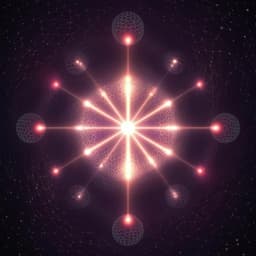
Physics
Light-wave-controlled Haldane model in monolayer hexagonal boron nitride
S. Mitra, Á. Jiménez-galán, et al.
This exciting research by Sambit Mitra, Álvaro Jiménez-Galán, and their colleagues explores optical control over time-reversal symmetry breaking in monolayer hexagonal boron nitride, achieving ultrafast switching in band structure configurations. This groundbreaking work paves the way for dynamic valley-selective bandgap engineering and few-femtosecond quantum switches.
~3 min • Beginner • English
Introduction
The study focuses on how discrete symmetries in quantum materials—spatial inversion and time reversal—govern electronic and topological properties. In hexagonal monolayers like graphene, preserving both symmetries yields Dirac cones at K and K′ with semimetal behavior. In monolayer hBN, broken inversion symmetry opens a large gap (~5.9 eV at K), producing insulating behavior with valleys at K and K′ that are time-reversal partners. Breaking time-reversal symmetry differentiates carrier dynamics between valleys, as in the Haldane model where complex next-nearest-neighbour (NNN) hoppings lift valley degeneracy, and in valleytronics where circularly polarized light induces valley-selective excitation. The research question is whether a tailored strong light waveform, matched to the crystal symmetry and rotated in space, can break time-reversal symmetry on subcycle timescales to realize a light-driven analogue of the Haldane model in an insulating 2D crystal (hBN), enabling ultrafast, valley-selective bandgap engineering and controllable valley polarization.
Literature Review
Prior work shows that stacking/twisting 2D materials with matching symmetry creates superlattice structures with emergent properties, further tunable by twist angle. Floquet engineering with long pulses can transiently modify crystal Hamiltonians via frequency, intensity, and helicity, altering band structures on pulse timescales. Light-wave electronics exploits subcycle control (CEP, multicolour delays) to steer coherent electronic transport faster than an optical cycle. Valleytronics has demonstrated helicity-dependent valley selection in gapped graphene and TMD monolayers, leading to valley Hall effects and optically controlled valley polarization. Topological models like Haldane’s toy model propose time-reversal symmetry breaking via staggered fields generating complex NNN hoppings. Experimental realizations of Haldane-like physics occurred in ultracold atoms, and Floquet engineering has been observed in topological insulators and excitonic systems. These studies motivate subcycle, non-resonant, symmetry-tailored light fields to engineer valley-dependent band structures in wide-gap insulators like hBN.
Methodology
Concept and theory: Two counter-rotating circularly polarized fields at frequencies ω and 2ω are interferometrically combined with an intensity ratio of 2:1 to produce a strong tailored light waveform whose in-plane projection forms a trefoil matching hBN’s threefold symmetry. Rotating the waveform by changing the subcycle delay between the ω and 2ω fields controls the orientation of the vector potential, which sets the phase of light-induced complex next-nearest-neighbour hoppings in a Haldane-type tight-binding description of laser-dressed hBN, thereby modulating valley-resolved bandgaps.
Simulations: Time-dependent simulations use a two-band model of gapped graphene with hBN parameters to compute conduction-band electron populations in the Brillouin zone after interaction with a trefoil field of fixed helicity at various orientations. The code approach follows Wannier-based crystal strong-field simulations (ref. 44). Predicted effective bandgap modulation at K and K′ for field strength F1 ≈ 0.7 V/Å and ω ≈ 0.6 eV exceeds 5 eV. Simulated 3ω helicity-resolved probe responses are evaluated for co- and counter-rotating helicities relative to the ω field.
Experiment: Sample: Monolayer hBN mounted on a 500 µm fused-silica substrate, with interaction confined to ~10 µm region (monocrystalline patch).
Pump (trefoil): Generated by combining counter-rotating circularly polarized pulses at 2 µm (ω, photon energy 0.6 eV) and 1 µm (2ω, photon energy 1.2 eV), ~30 fs duration, intensity ratio 2:1. Pump intensity in air: ~4–7 TW/cm² without observed damage. The trefoil orientation relative to the fixed hBN lattice is controlled by subcycle delay Δt between ω and 2ω pulses.
Probe and detection: A small portion of the 2 µm (ω), linearly polarized, ~30 fs pulse is delayed by Δt_pump–probe ≈ 60–120 fs and used to probe via third-harmonic (3ω) generation. The probe induces a drift current (proportional to vector potential) and an anomalous Hall current (proportional to electric field and Berry curvature weighting of valley populations). Owing to a π/2 phase offset between these components, the emitted 3ω becomes elliptically polarized when valley populations are imbalanced. Berry curvature has opposite sign at K and K′. The valley polarization is mapped onto the asymmetry α = (S1 − S2)/(S1 + S2) of helicity-resolved 3ω components S1 (co-rotating) and S2 (counter-rotating). The 3ω polarization state is analyzed with a quarter-wave plate and a Wollaston prism to separate s- and p-polarized components, detected by two photodiodes connected to a two-channel lock-in amplifier. The fused-silica substrate alone serves as a control (no modulation vs rotation).
Data analysis: As the pump trefoil is rotated, helicity-resolved 3ω signals are recorded and binned; FFT identifies periodicities (notably 120° and a weaker 60° harmonic). Fourier filtering isolates the 120° component to extract phase, amplitude, and α for comparison with simulations.
Key Findings
- Realization of a light-driven analogue of the Haldane model in monolayer hBN by a trefoil light waveform that induces complex next-nearest-neighbour hoppings, breaking time-reversal symmetry and lifting K/K′ valley degeneracy.
- Rotating the waveform (via ω–2ω subcycle delay) controls the CNNN hopping phase and modulates the valley-resolved bandgaps: one valley’s gap widens while the other narrows, with 120° periodicity matching lattice symmetry.
- Predicted effective bandgap modulation at K and K′ exceeds 5 eV for F1 ≈ 0.7 V/Å and ω ≈ 0.6 eV under experimental conditions.
- Time-dependent simulations show conduction-band population predominantly in the valley with the reduced gap; valley polarization oscillates and switches with trefoil orientation for fixed helicity, with additional helicity-dependent dichroism causing a weaker 60° component.
- Experimentally, helicity-resolved 3ω signals from hBN display strong 120° periodic oscillations (and a discernible 60° second harmonic in one channel) as a function of trefoil rotation; the fused-silica control shows no such modulation.
- The phase difference between the two helicity channels and the extracted asymmetry α match time-dependent simulations (performed at pump intensity ~7 TW/cm²), confirming valley-contrasting dynamics.
- The probe’s third harmonic becomes elliptically polarized with opposite helicity depending on whether K or K′ is more populated, evidencing a non-zero valley Hall current during the probe.
- Estimated valley lifetime in hBN under strong tailored fields is ~60 fs at ambient temperature (~nine optical cycles), enabling few-femtosecond, non-resonant valleytronics in a wide-gap insulator.
Discussion
The results address the central goal of subcycle, symmetry-tailored control of valley-dependent band structures in an insulating 2D crystal. Matching and rotating a trefoil light waveform relative to the hBN lattice establishes a laser-dressed Haldane-type Hamiltonian with controllable complex NNN hoppings, enabling real-time modulation of valley bandgaps and populations. The observed 120° periodic modulation of helicity-resolved third-harmonic signals, their phase relation, and agreement with simulations validate that waveform orientation (not only field helicity) dominantly controls valley selectivity in the below-resonant, strong-field regime. The presence of a weaker 60° harmonic reflects residual helicity-dependent valley dichroism and the fact that a pure time-reversal partner requires both orientation and helicity reversal. The demonstrated light-driven, symmetry-protected valley bandgap engineering is robust, reversible, and preserves coherence on subcycle timescales, expanding valleytronics to wide-gap insulators and opening opportunities for ultrafast, room-temperature switching and band-structure reconfiguration in 2D materials.
Conclusion
This work introduces a light-wave-driven counterpart to twisted layer stacking by using a trefoil waveform to realize and control a Haldane-type Hamiltonian in monolayer hBN. By rotating the waveform, the magnitude, position, and curvature of the bandgap can be dynamically tuned, producing oscillatory and switchable valley polarization detectable via time-resolved harmonic polarimetry. The approach extends valleytronics to the few-femtosecond regime and to wide-gap insulating monolayers, with an estimated valley lifetime of ~60 fs under strong tailored fields. The method’s universality and symmetry robustness suggest applications in ultrafast, on-the-fly valley-selective bandgap engineering. Future directions include integrating alternative probes (e.g., ARPES or transport Hall measurements), exploring other material systems (semiconducting/insulating monolayers and heterostructures), and spatially patterning the trefoil orientation to create micrometre-scale domains analogous to moiré superlattices for tailored electronic functionalities.
Limitations
- Complete inversion of valley populations purely by rotating the trefoil field is hindered by helicity-dependent valley dichroism; achieving the exact time-reversal partner requires changing both the waveform orientation and its helicity.
- The demonstrated valley polarization persists for ~60 fs at room temperature, setting a temporal window for functional operation.
- Valley population was inferred indirectly via third-harmonic polarimetry; direct transport or momentum-resolved probes were not implemented here (though proposed as compatible).
- The interaction region is limited to ~10 µm monocrystalline patches on fused silica, which may constrain uniformity and scalability in current experiments.
- Operation relies on strong below-resonant fields (pump ~4–7 TW/cm²), which may impose constraints on practical device integration and material damage thresholds, even though no damage was observed here.
Related Publications
Explore these studies to deepen your understanding of the subject.







